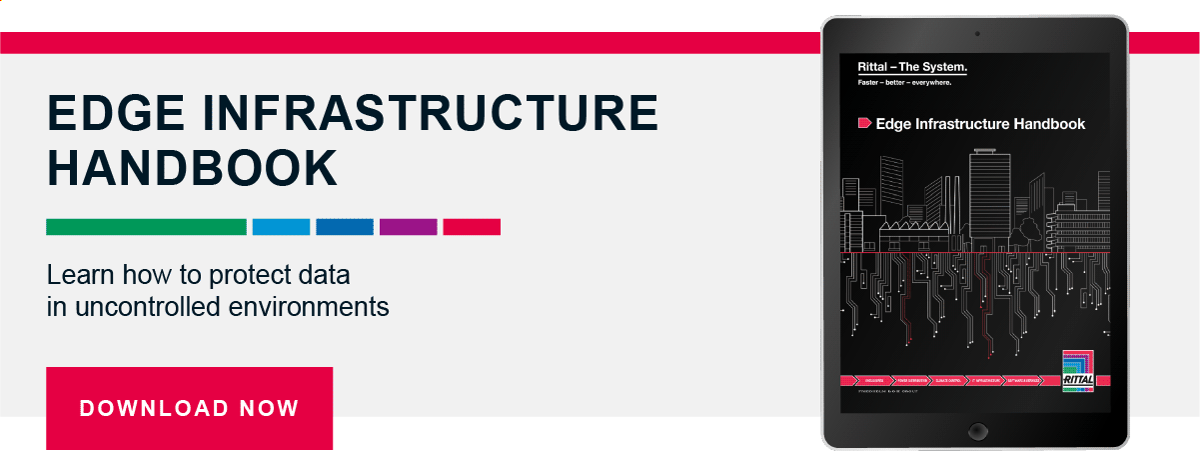
You likely know the benefits of Edge computing: reduced data latency (more speed), ability to handle a lot of data (reliability), bandwidth optimization (cost savings). Gathering data close to the source using Internet of Things (IoT) devices is no longer just necessary but expected, inspiring companies to relocate processing functions and rethink their approaches to IT infrastructure and network operations.
Failing to invest in Edge computing today could put companies in the tough position of playing catch-up to competitors in the future. Before you consider an Edge deployment, however, it is vital to explore and scrutinize your current Edge infrastructure. This article offers 6 tips to help prepare your location for what is to come.
1. Think “Data Center”
Edge deployments are simply very small-scale installations in any locations that ARE NOT a traditional IT space. And at the furthest point from the corporate core of the network. Scaling slightly up in size, other Edge deployments could be installed in a container or another pre-engineered solution, providing a local mesh network for the standalone installations. These locations, anywhere but in a data center, demand special attention to ensure a stable and secure installation.
Whichever IT infrastructure is going to be used, it is vital to consider the environmental factors that impact IT equipment performance: air quality, dust/debris/moisture, access control, power outages, temperature fluctuations, etc. In other words, although not in the IT space we normally picture, the Edge deployment is a single footprint data center and must have all the support systems (power, climate control, physical security, monitoring) critical to any IT deployment.
2. Consider Redundancy
Different Edge deployments (and different industries) require various levels of redundancy. While just an hour of downtime may cost one organization $100,000 or more, another company is not hurt quite so much. This makes redundancy a choice.
- Is it “mission critical”?
- Is it duplicated on a local or company-wide level?
- Can it be supported locally?
- Can you afford to not have 100% availability?
For every Edge deployment, you should also answer these questions: What is your acceptable level of redundancy? Does your current IT infrastructure include a reliable power supply with backup, perhaps a separate uninterrupted power supply (UPS) and proper cooling? Will the level of redundancy support my required resiliency?
3. Integrate Climate Control
Years ago, physically checking temperature and equipment performance within the environment of your IT infrastructure was the main way to prevent failure. Today, a skilled technician will most likely use remote management tools to monitor your Edge system.
When thinking about preparing your Edge infrastructure, a monitoring system for climate control components shares important operational parameters: temperature, set points for all critical parameters, device status, and real-time alarms (email or text). When you are offsite, wherever you are, climate control is optimally integrated into your Edge infrastructure.
For the Blue e+ air conditioners, the IoT Interface provides real-time monitoring and network communications. For larger Edge installations, a system that provides active and automated monitoring and controlling of network/server racks is Rittal’s CMC III. You fully control access, get real-time collection of environmental conditions, and receive notifications when an alarm is triggered.
4. Scale-Up Within Your Space
Monitoring can also help as you plan and maximize available space. For a small space (think of the typical IT closet or a modular security room), remote monitoring of two or three network/server racks is not as vital as a truly remote location. The fact is, monitoring becomes more and more critical the further out it is from your data center space.
When it comes to available space, Edge infrastructure should include the ability to scale up as needed. This could be to add accessories quickly or reconfigure the cabinet. It’s important to keep the power equipment installed in the same cabinet as the IT equipment.
5. Prioritize Security
Perhaps the toughest challenge of an Edge deployment is establishing and maintaining security. These standalone installations do not have the security advantages enjoyed within a big data center.
With the large amount of data being gathered, organizations simply cannot risk a data breach, and valuable equipment itself must be protected. Vulnerability is never a good thing, yet you must decide how much physical protection is required; there’s a big difference between dust-proof and bomb-proof.
Other than unauthorized access, the two biggest physical threats are dust and water. These could easily damage IT equipment and cost you money, so you need to determine your security needs based on your Edge infrastructure’s specific conditions.
When considering physical security, the conversation instantly shifts to network/server racks.
6. Choose IT Cabinets Wisely
Maximum protection for any IT environment, Edge deployment or another, requires overall security awareness and a focus on your last line of defense: the IT cabinet. Obviously, a harsh environment in which temperature and air flow quickly change — such as a manufacturing facility, oil rig, or wind turbine farm — calls for an IT cabinet that performs under specific conditions to meet the needs of that Edge deployment.
By selecting IT cabinets that prioritize security, you are instantly helping reduce physical break-ins. Certain security initiatives — internal hinges, multi-point lock rods, frame design, and others — are part of a well-engineered cabinet.
IT cabinet manufacturers understand the demands of Edge deployments and the need to properly prepare an Edge infrastructure. This upfront work helps determine the right protection based on the location and inevitable risks associated with it. Another benefit of a solid, trusted partnership is being able to look ahead and select cabinets that are capable of scaling with you. Modular cabinets are often the answer because they do not require cutting or welding to modify.
The only way to be 100% sure that an IT cabinet is right for your Edge deployment is to consult with an expert. Just make sure to ground your thinking with the conditions and risks of your specific Edge environment.



